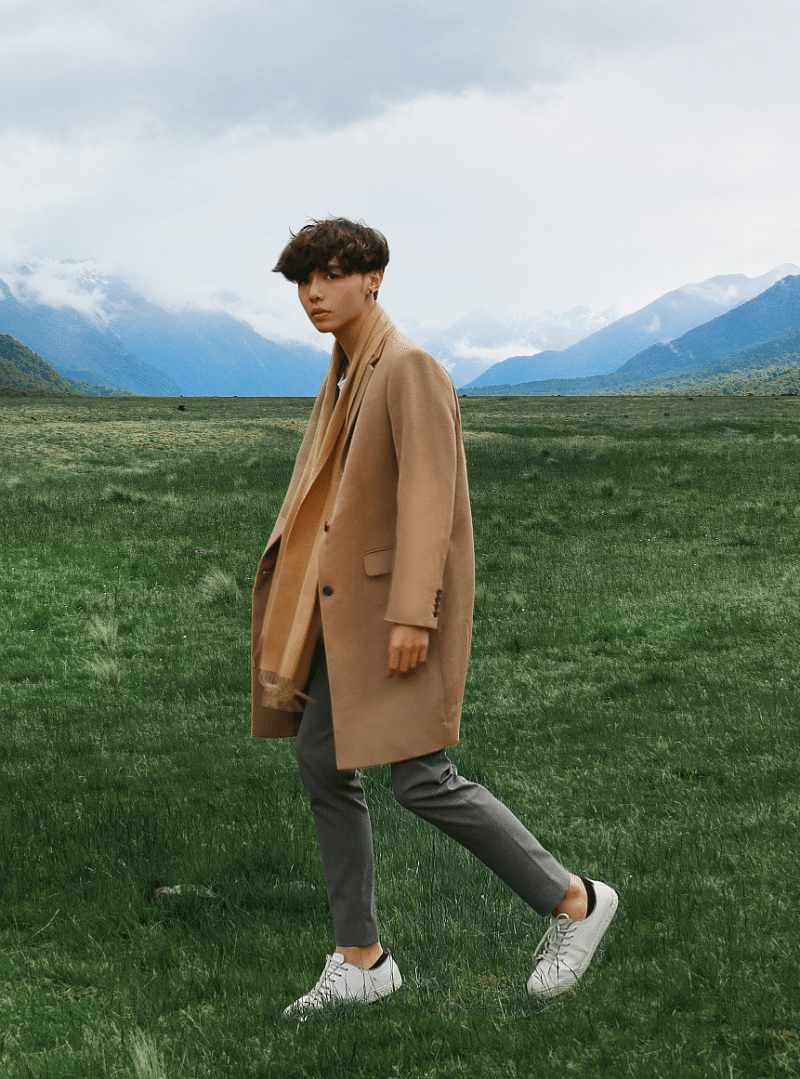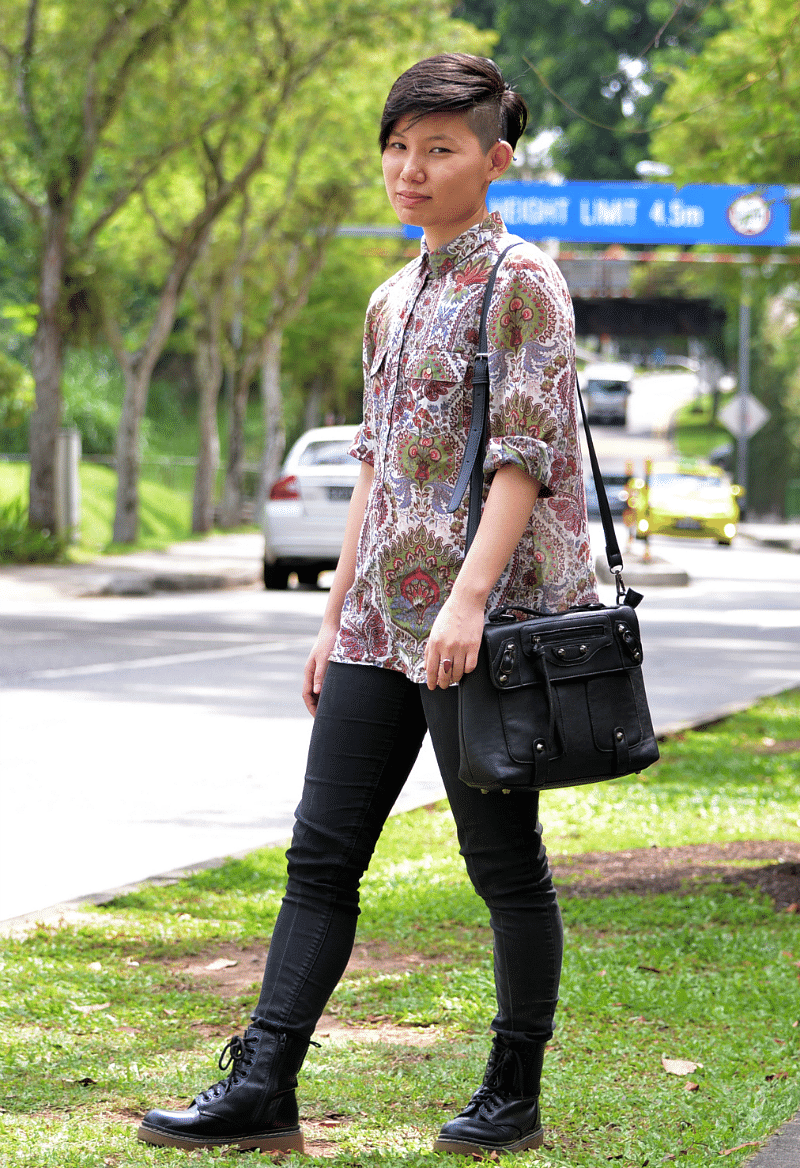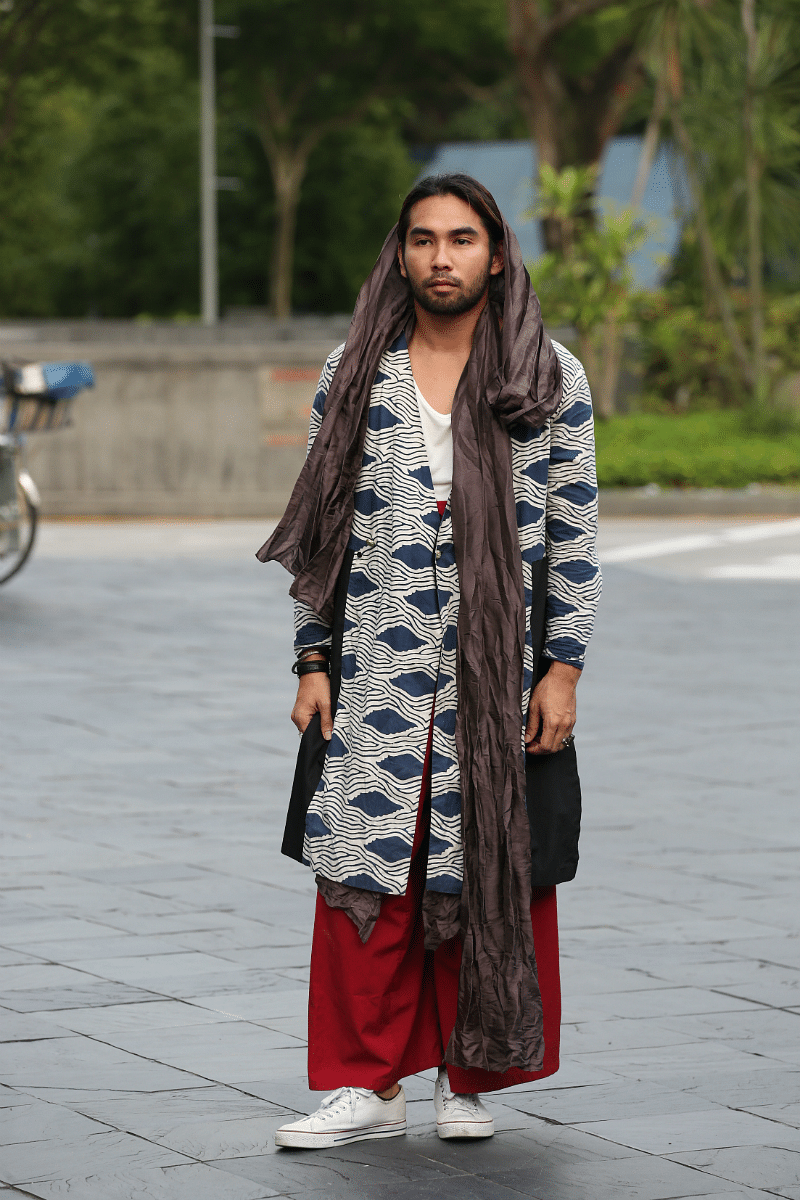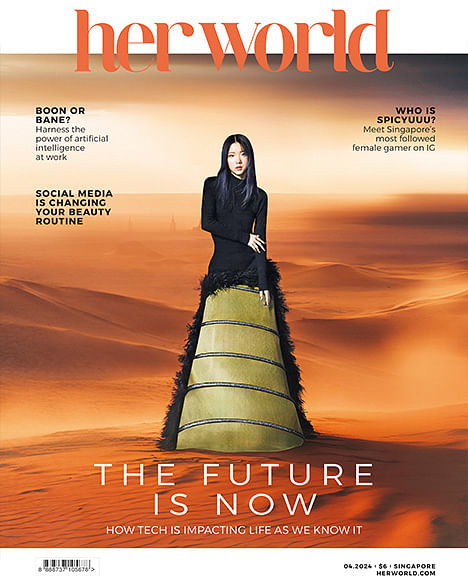
Photo: The Straits Times/Daryl Aiden Yow
To most, Mr Daryl Aiden Yow – with his structured coats, skinny jeans and colourful scarves – is just another fashion-forward metrosexual man.
But few know that most of the 25-year-old’s wardrobe comprises pieces bought from the women’s section of his favourite stores here: Uniqlo, Topshop and Guess.
The full-time fashion photographer owns over 25 pairs of skinny jeans, 30 coats and three drawers of accessories such as hats and scarves – 60 per cent from the women’s section – which he describes as a “treasure trove”.
“Women’s clothing tends to fit me better and be a lot more creative, colourful and detail-oriented compared to those made for a male consumer,” he says, adding that he likes boxy cuts, loose silhouettes and colour blocking. “I’m always looking for statement pieces such as shawls, hats and loose culottes to jazz up the basics I pick up from the men’s section.
“I see no reason to avoid buying something just because it is located in the women’s section of a store,” he says.
It seems that Mr Yow is not alone in breaking conventional gender rules that have long existed in fashion.
Although there are no polls done locally, a study this year from the United States by trend-forecasting agency J. Walter Thompson Innovation Group, found that only 44 per cent of Generation Z – the demographic cohort born after the millennials – and 54 per cent of millennials reported shopping for clothing designed specifically for their own gender, pointing to a horde of consumers refusing to play by traditional rules of gender dichotomies.
According to freelance stylist Jerome Tan, 33, androgyny’s rise here has been largely attributed to a mix of open-mindedness and the rise of street style.
“Not only are young people more likely to experiment with their clothing these days, thanks to social media, they also have more avenues to explore different ways of styling pieces,” he says.
“It’s therefore less likely that people will bat an eyelid if a woman is wearing a masculine watch or a man is accessorising with a printed scarf. The street-style culture has made consumers much more accepting of varied styles of dressing.”
Though androgynous dressing is by no means new in fashion history – Yves Saint Laurent first launched tuxedos for women in the 1960s, and entertainers such as The Beatles, David Bowie, Prince and Grace Jones have embraced gender-fluid style since the 1970s – its resurgence in recent years has been largely consumer-driven, with people shunning societal norms when it comes to their fashion sensibilities.
Retail brands, from global fast- fashion to high-end couture, are now racing to capture and market to the new wave of shoppers – having noticed the cultural shift.
Last January, Louis Vuitton featured musician and actor Jaden Smith, the 18-year-old son of actors Will Smith and Jada Pinkett Smith, in its womenswear campaign, wearing a leather jacket, fringed shirt and skirt.
In August, rapper Young Thug made waves when he appeared on his album cover in a froufrou-tiered dress.
And in October, American makeup brand CoverGirl announced 17-year-old make-up artist James Charles as its first male spokesman in its 55-year history. The high school senior, who is known for his flamboyant and highlighter-heavy make-up looks, will appear in campaigns for CoverGirl’s newest mascara, So Lashy.
Trickling down to the high street, mass-market brands are embracing gender-neutrality and pushing unisex clothing collections.
In March this year, fast-fashion retailer Zara launched its first attempt at gender-free clothing in Singapore and globally – a new range called Ungendered, with promotional images for the collection featuring male and female models wearing the same items. The range includes sweatshirts, T-shirts and trousers.
Guess soon followed suit with the His + Hers collection, its first unisex line featuring jeans, joggers, sweatshirts, T-shirts, blazers, button-down shirts and outerwear in monochromatic and neutral hues. It has been available at stores here since October 3.
Closer to home, Hong Kong- based fashion and lifestyle concept store, kapok, also launched a line of gender-neutral clothing called Future Classics in July this year. The collection, which offers basics such as T-shirts, shirt dresses, pants and shorts, was a year and a half in the making.
The founder of kapok, Mr Arnault Castel says: “Gender-free clothing to me represents freedom. You get to wear clothes because of how you want to look and feel, and not because society has decided what you have to wear based on your gender. I really like that freedom.”
Local designer Max Tan, who is behind womenswear label Max.Tan, has some male customers. “They tend to gravitate towards the 20 per cent of my line that is quite oversized and gender neutral. I think it’s because there is a gap in the men’s fashion market for design-focused clothing at a lower price point.”
Graphic designer Chia Shu Ying, 28, who chopped off her waist- length hair into a short do with an undercut six months ago, is a proponent of the gender-fluid trend.
“My new hairstyle meant changing my style as well, I now opt for pieces that give me a clean, casual silhouette – sort of like a feminine boy. It’s a look that I feel suits my small frame best,” says the former national level cheerleader, who used to wear dresses and skirts.
She says that friends and family have been positive and encouraging.
“My boyfriend was, in fact, more excited about me cutting my hair than I was. No one seems to think it’s weird just because I’m not dressing like a conventionally feminine woman,” she says, adding that a typical outfit for her now consists of jeans, collared or button-up blouses and boots.
Artist and director Irfan Kasban agrees that people in his age group have become more accepting of androgynous styles of dressing.
The 28-year-old, who tailors nearly half of the pieces in his wardrobe, gravitates towards loose and flowy pieces with an Asian aesthetic – think Indian-inspired kurta tops, batik sarongs and clogs.
“I almost never wear regular pants,” he says. “If you look at the history of style in South-east Asia, it’s always been very comfortable and somewhat gender-neutral, which is why I like to challenge what society perceives as conventionally feminine or masculine.”
These days, he can be found matching basics from the men’s section with chunky crystal jewellery and tying everything together with a jacket or sarong that he got tailored in Arab Street.
“The way I dress is more for myself. I understand from the stares that my style is quite out there,” he says. “But even if I hold an office job, I would still dress like this in my down time. Style is so personal, and mine is an aesthetic that speaks to me.”
But freelance fashion stylist Evon Chng, 28, who opts for an edgy and more adventurous look when she is not working on shoots, thinks that there is still a long way to go before Singaporeans fully embrace more gender-fluid dressing.
She and her boyfriend, Joseph Ho, are big fans of the dark, androgynous pieces by American fashion designer Rick Owens, but wearing the brand’s leather boots or drop-crotch skorts (shorts with a fabric panel resembling a skirt covering the front) has often elicited stares from curious passers-by.
Ms Chng says: “I think women can get away with wearing looks that are masculine or androgynous, but it is not the same for men. Men who wear skirts or conventionally feminine pieces are still being judged by society today.”
The duo, though, seem not to mind the attention they get when they are out together.
Mr Ho shares his monochromatic gender-neutral wardrobe with his younger brother and has even gotten his mother on board – she now owns a pair of Rick Owens boat shoes.
The 29-year-old entrepreneur says: “I believe in individualism when it comes to personal style. People might think certain pieces look conventionally feminine or masculine, but I look at interesting construction, fabric and details in the clothes I wear.
“I enjoy looking different – it’s cool when clothes can be a talking point.”

Photo: The Straits Times/Aziz Hussin
Chia Shu Ying, graphic designer, 28
Inspiration: A radical hairstyle change six months ago
Favourite piece: Military combat boots (pictured) from Marco Republic, US$24.95 (S$35.55) from Amazon.com
On her style: “I used to love the glam rock vibe when I was younger, but when I began cheerleading competitively, I dressed in a more feminine way as it suited my long hair. Now with my short hair, I feel more liberated and I feel like I’ve come full circle with my style. I feel like my hair lets me rock more androgynous looks.”

Photo: The Straits Times/Daryl Aiden Yow
Daryl Aiden Yow, photographer, 25
Inspiration: Japanese and Korean street style
Favourite piece: Women’s satin ankle length pants from Uniqlo, $49.90
On reactions to his style: “People constantly ask me where I got my pieces and are often surprised to hear that they are from the female section. It just goes to show that what is important is how you pull off a piece of clothing – it shouldn’t matter which section of the store you got it from.”

Photo: The Straits Times/Lau Fook Kong
Irfan Kasban, artist, 28
Inspiration: Asian-inspired pieces such as sarongs and kurtas
Favourite piece: A batik-printed overcoat which he got tailored at a store in Arab Street for $250
On his family’s reaction to his style: “I think they used to be adverse to it back in the day, but they’ve definitely come around now. That’s how I feel when I get stares from strangers – I don’t mind because it will always be a process before society accepts a style that is unconventional. I’m okay to let it slide because I happen to like the way I look – sarongs, man bun and all.”

Photo: The Straits Times/Chew Seng Kim
Evon Chng, freelance fashion stylist, 28
Inspiration: Designers such as Rick Owens and Comme Des Garcons
Favourite piece: Comme Des Garcons x Good Design Shop polyester jacket from the Good Design Shop, $200
On trying new things: “I’m always open to experimenting with my looks. I’m lucky because I work in the fashion industry where clients are accepting of different styles and it’s allowed me to experiment with different looks over the years .”
Joseph Ho, entrepreneur, 29
Inspiration: Designers such as Rick Owens and Carol Christian Poell
Favourite piece: Rick Owens embroidered bomber jacket (left, worn by Ms Chng) from Grailed.com
On his unique style: “I wear a lot of monochromatic colours because I find them easy to match – I even wore black on Chinese New Year. I see nothing wrong with wearing gender-neutral pieces such as skorts. I enjoy pieces that have interesting details and construction because they look unique – the individualism in fashion is what I enjoy the most.”
The original version of this story was published in The Straits Times on December 1, 2016.
For more of the latest fashion trends and tips, check out www.herworldplus.com/fashion.

